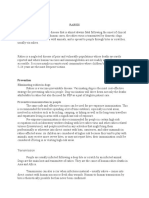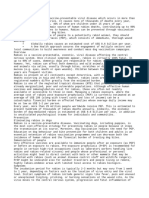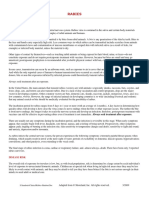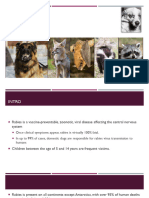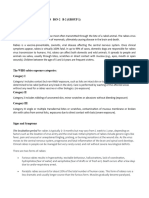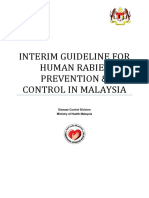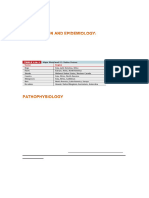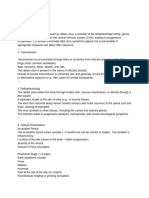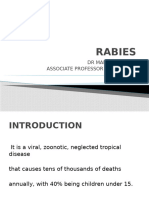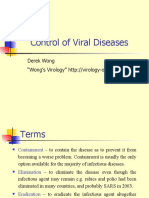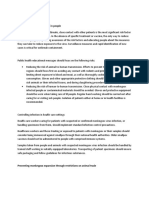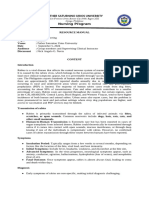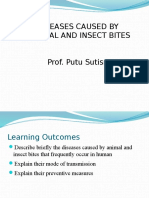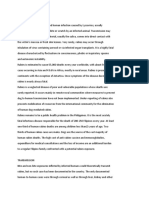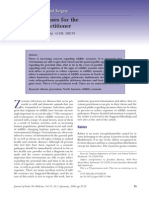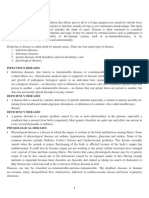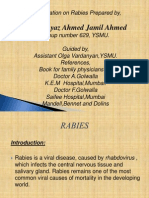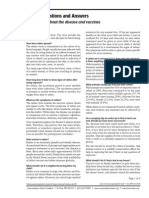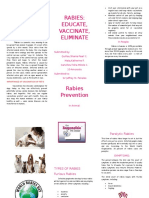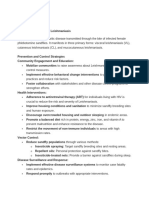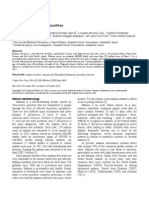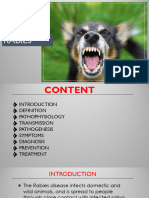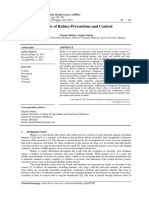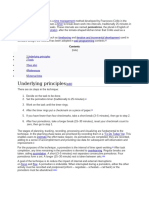Êy Êy Êy Êy Êy
Êy Êy Êy Êy Êy
Uploaded by
Yel CMCopyright:
Available Formats
Êy Êy Êy Êy Êy
Êy Êy Êy Êy Êy
Uploaded by
Yel CMOriginal Title
Copyright
Available Formats
Share this document
Did you find this document useful?
Is this content inappropriate?
Copyright:
Available Formats
Êy Êy Êy Êy Êy
Êy Êy Êy Êy Êy
Uploaded by
Yel CMCopyright:
Available Formats
Calayag, Yel C.
Rabies // WHO
Key facts
y y y y y y
Rabies occurs in more than 150 countries and territories. Worldwide, more than 55 000 people die of rabies every year. 40% of people who are bitten by suspect rabid animals are children under 15 years of age. Dogs are the source of 99% of human rabies deaths. Wound cleansing and immunization within a few hours after contact with a suspect rabid animal can prevent the onset of rabies and death. Every year, more than 15 million people worldwide receive a post-exposure preventive regimen to avert the disease this is estimated to prevent 327 000 rabies deaths annually. Rabies is a zoonotic disease (a disease that is transmitted to humans from animals) that is caused by a virus. The disease infects domestic and wild animals, and is spread to people through close contact with infected saliva via bites or scratches. Rabies is present on all continents with the exception of Antartica, but more than 95% of human deaths occur in Asia and Africa. Once symptoms of the disease develop, rabies is nearly always fatal. Symptoms The incubation period for rabies is typically 13 months, but may vary from <1 week to >1 year. The initial symptoms of rabies are fever and often pain or an unusual or unexplained tingling, pricking or burning sensation (paraesthesia) at the wound site. As the virus spreads through the central nervous system, progressive, fatal inflammation of the brain and spinal cord develops. Two forms of the disease can follow. People with furious rabies exhibit signs of hyperactivity, excited behaviour, hydrophobia and sometimes aerophobia. After a few days, death occurs by cardio-respiratory arrest. Paralytic rabies accounts for about 30% of the total number of human cases. This form of rabies runs a less dramatic and usually longer course than the furious form. The muscles gradually become paralyzed, starting at the site of the bite or scratch. A coma slowly develops, and eventually death occurs. The paralytic form of rabies is often misdiagnosed, contributing to the underreporting of the disease. Diagnosis No tests are available to diagnose rabies infection in humans before the onset of clinical disease, and unless the rabies-specific signs of hydrophobia or aerophobia are present, the clinical diagnosis may be difficult. Post mortem, the standard diagnostic technique is to detect rabies virus antigen in brain tissue by fluorescent antibody test. Transmission
People are infected through the skin following a bite or scratch by an infected animal. Dogs are the main host and transmitter of rabies. They are the source of infection in all of the estimated 55 000 human rabies deaths annually in Asia and Africa. Bats are the source of most human rabies deaths in the United States of America and Canada. Bat rabies has also recently emerged as a public health threat in Australia, Latin America and western Europe. Human deaths following exposure to foxes, raccoons, skunks, jackals, mongooses and other wild carnivore host species are very rare. Transmission can also occur when infectious material usually saliva comes into direct contact with human mucosa or fresh skin wounds. Human-to-human transmission by bite is theoretically possible but has never been confirmed. Rarely, rabies may be contracted by inhalation of virus-containing aerosol or via transplantation of an infected organ. Ingestion of raw meat or other tissues from animals infected with rabies is not a source of human infection. Treatment after exposure Effective treatment soon (within a few days, but as soon as possible) after exposure to rabies can prevent the onset of symptoms and death. Post-exposure prevention consists of local treatment of the wound, administration of rabies immunoglobulin (if indicated), and immediate vaccination. Local treatment of the wound Removing the rabies virus at the site of the infection by chemical or physical means is an effective means of protection. Therefore, prompt local treatment of all bite wounds and scratches that may be contaminated with rabies virus is important. Recommended first-aid procedures include immediate and thorough flushing and washing of the wound for a minimum of 15 minutes with soap and water, detergent, povidone iodine or other substances that kill the rabies virus. Recommended treatment The recommended post-exposure prophylaxis depends on the type of contact with the suspected rabid animal (see table). Table: Recommended post-exposure prophylaxis for rabies infection
Category of exposure to suspect rabid animal
Post-exposure measures
Category I touching or feeding animals, licks on intact skin (i.e. no exposure) None Category II nibbling of uncovered skin, minor scratches Immediate vaccination or abrasions without bleeding treatment of the wound and local
Category III single or multiple transdermal bites or Immediate vaccination and scratches, licks on broken skin; contamination of mucous administration of rabies membrane with saliva from licks, exposures to bats. immunoglobulin; local treatment of the
Table: Recommended post-exposure prophylaxis for rabies infection wound Other factors that should be taken into consideration when deciding whether to initiate postexposure prevention include: the likelihood of the implicated animal being rabid the clinical features of the animal and its availability for observation and laboratory testing. In developing countries, the vaccination status of the suspected animal alone should not be considered when deciding whether to initiate prophylaxis or not. Who is most at risk? Dog rabies potentially threatens over 3.3 billion people in Asia and Africa. People most at risk live in rural areas where human vaccines and immunoglobulin are not readily available or accessible. Poor people are at a higher risk, as the average cost of rabies post-exposure prophylaxis after contact with a suspected rabid animal is US$ 40 in Africa and US$ 49 in Asia, where the average daily income is about US$ 12 per person. In India, 20 000 rabies deaths (that is, about 2/100 000 population at risk) are estimated to occur annually; in Africa, the corresponding figure is 24 000 (about 4/100 000 population at risk). Although all age groups are susceptible, rabies is most common in children aged under 15; on average 40 % of post-exposure prophylaxis regimens are given to children aged 514 years, and the majority are male. Anyone in continual, frequent or increased danger of exposure to rabies virus either by nature of their residence or occupation is also at risk. Travellers with extensive outdoor exposure in rural high-risk areas where immediate access to appropriate medical care may be limited should be considered at risk regardless of duration of their stay. Children living in or visiting rabiesaffected areas are at particular risk. Prevention Eliminating rabies in dogs Rabies is a vaccine-preventable disease. The most cost-effective strategy for preventing rabies in people is by eliminating rabies in dogs through vaccination. Vaccination of animals (mostly dogs) has reduced the number of human (and animal) rabies cases in several countries, particularly in Latin America. However, recent increases in human rabies deaths in parts of Africa, Asia and Latin America suggest that rabies is re-emerging as a serious public health issue. Preventing human rabies through control of domestic dog rabies is a realistic goal for large parts of Africa and Asia, and is justified financially by the future savings of discontinuing postexposure prophylaxis for people. Preventive immunization in people Safe, effective vaccines also exist for human use. Pre-exposure immunization in people is recommended for travellers to high-risk areas in rabies-affected countries, and for people in certain high-risk occupations such as laboratory workers dealing with live rabies virus and other
y y
lyssaviruses, and veterinarians and animal handlers in rabies-affected areas. As children are at particular risk, their immunization could be considered if living in or visiting high risk areas. WHO response WHO promotes wider access to appropriate post-exposure treatment using modern tissue culture or avian embryo-derived rabies vaccines through: use of the multi-site intradermal regimen to reduce the cost of post-exposure treatments; increased production of safe and efficacious rabies biologicals, which are in critical short supply globally, particularly rabies immunoglobulin; continuing education of health and veterinary professionals in rabies prevention and control; and immunization of 70% of the dog population to stop circulation of the virus at source
y y y y
You might also like
- A2 Pe Coursework Examples HockeyDocument6 pagesA2 Pe Coursework Examples Hockeyafiwgjbkp100% (2)
- RabiesDocument81 pagesRabiesSujatha J Jayabal100% (1)
- Cpms College of Nursing: Assignment ON Electrocardiogram (ECG)Document6 pagesCpms College of Nursing: Assignment ON Electrocardiogram (ECG)Amy Lalringhluani Chhakchhuak100% (3)
- RabiesDocument3 pagesRabiesitsmeayaNo ratings yet
- Rabies: UnderstandingDocument17 pagesRabies: UnderstandingMzsvtm MacapagalNo ratings yet
- RabiesDocument2 pagesRabiesjodamotNo ratings yet
- Monkey PoxDocument4 pagesMonkey PoxPrince Mark BadilloNo ratings yet
- RabiesDocument9 pagesRabiesHarshal Sabane100% (1)
- CHN RabiesDocument28 pagesCHN RabiesOthmaen Parec Jr.No ratings yet
- Rabies Prevention and ControlDocument9 pagesRabies Prevention and ControlJames RiedNo ratings yet
- RabiesDocument2 pagesRabiesChhaviNo ratings yet
- RabiesDocument16 pagesRabiesemansaleem68No ratings yet
- What's Monkeypox ?Document10 pagesWhat's Monkeypox ?Fumika VenayaNo ratings yet
- Animal BitesDocument5 pagesAnimal BitesakiNo ratings yet
- RabiesDocument2 pagesRabiesPhoebe Jeanne AlfafaraNo ratings yet
- Interim Guideline For Prevention and Control of Human Rabies in MalaysiaDocument17 pagesInterim Guideline For Prevention and Control of Human Rabies in MalaysiaKesavanVeera100% (1)
- Rabies 1Document31 pagesRabies 1minahil qadeerNo ratings yet
- Introduction CASE STUDYDocument3 pagesIntroduction CASE STUDYDavid CalaloNo ratings yet
- Rabies HE FinalDocument8 pagesRabies HE FinalRikkimae NaagNo ratings yet
- Rabies NotesDocument9 pagesRabies Notesomar.ahmedqrNo ratings yet
- Rabies Vaccines WHO Position PaperDocument14 pagesRabies Vaccines WHO Position PaperMark Anthony BernasNo ratings yet
- RabiesDocument4 pagesRabiespavanda716No ratings yet
- Zoonotic DiseasesDocument42 pagesZoonotic DiseasesMylz MendozaNo ratings yet
- WHO Guide For Rabies Prevention Strategy. Updated 2018Document12 pagesWHO Guide For Rabies Prevention Strategy. Updated 2018candida samNo ratings yet
- Rabies: Clinical FeaturesDocument3 pagesRabies: Clinical FeaturessivaNo ratings yet
- Monkey_pox_English VersionDocument2 pagesMonkey_pox_English Versionpatriciawin1No ratings yet
- RABIESDocument15 pagesRABIESVincent OrjiNo ratings yet
- Control of Viral Diseases: Derek WongDocument43 pagesControl of Viral Diseases: Derek WongAyioKunNo ratings yet
- What Is Rabies?Document9 pagesWhat Is Rabies?Bijay Kumar MahatoNo ratings yet
- Bio ProjDocument12 pagesBio Projsb132086No ratings yet
- Reducing The Risk of Infection in PeopleDocument2 pagesReducing The Risk of Infection in PeopleyessicaNo ratings yet
- Plaque Pest, Black Death, Pestilential Fever: Veterinary Medicine-UBDocument16 pagesPlaque Pest, Black Death, Pestilential Fever: Veterinary Medicine-UBmuhammadsugi23No ratings yet
- Rabies: Questions and Answers: Information About The Disease and VaccinesDocument4 pagesRabies: Questions and Answers: Information About The Disease and VaccinesJcigSolarInstallationNo ratings yet
- Rabies: 1 and 3 PeopleDocument6 pagesRabies: 1 and 3 PeopleDumapis RichardNo ratings yet
- Vector and Zoonoses Control 2017Document15 pagesVector and Zoonoses Control 2017Patricia Espina100% (1)
- RM1 NaviaDocument2 pagesRM1 NaviaNikolas WRNo ratings yet
- The Impact of Infective Immigrants On The Spread of Dog RabiesDocument10 pagesThe Impact of Infective Immigrants On The Spread of Dog Rabiestibebu tuluNo ratings yet
- AnthraxDocument5 pagesAnthraxSaman SarKoNo ratings yet
- Vector Borne Diseases: Prof. Dr. Syed Sanowar AliDocument44 pagesVector Borne Diseases: Prof. Dr. Syed Sanowar AliAli100% (1)
- What Is Rabies? How Do People and Animals Get The Disease?Document14 pagesWhat Is Rabies? How Do People and Animals Get The Disease?lea nicole iglesiasNo ratings yet
- Lassa FeverDocument5 pagesLassa FeverOthmaen Parec Jr.No ratings yet
- Science CleranceDocument5 pagesScience ClerancenisniqtrdaNo ratings yet
- Animal and Insect Bites DiseasesDocument28 pagesAnimal and Insect Bites DiseasesAditya PrabawaNo ratings yet
- My Notes On RabiesDocument2 pagesMy Notes On RabiesAlma RotaNo ratings yet
- Malaria: Nama: Rismawati NIM: C 111 09 752Document6 pagesMalaria: Nama: Rismawati NIM: C 111 09 752Rismawati AcenkNo ratings yet
- Wildlife ZoonosesDocument8 pagesWildlife ZoonosesPavan KumarNo ratings yet
- Zoonoses - 06.11.2023Document53 pagesZoonoses - 06.11.2023johnnycash5404No ratings yet
- Yellow FeverDocument31 pagesYellow FeverVibha AvasthiNo ratings yet
- About Monkey PoxDocument3 pagesAbout Monkey PoxObakoma Josiah100% (1)
- Community Health Nursing - 1 MahirDocument37 pagesCommunity Health Nursing - 1 Mahirvhoramahir100% (1)
- Rabies 2Document20 pagesRabies 2august gurniwaNo ratings yet
- Rabies QuestionDocument4 pagesRabies QuestionRichardDumlaoNo ratings yet
- Rabies: Educate, Vaccinate, EliminateDocument2 pagesRabies: Educate, Vaccinate, EliminateKimberlyDeSmetNo ratings yet
- Animal BitesDocument5 pagesAnimal BitesvyalylaNo ratings yet
- PathogensDocument5 pagesPathogensKarl Louie PabustanNo ratings yet
- Prevention and Control Leishmaniasis and PlagueDocument4 pagesPrevention and Control Leishmaniasis and Plagueogachico1No ratings yet
- Malaria in Developing Countries: Review ArticleDocument4 pagesMalaria in Developing Countries: Review ArticleJavierFelipeRodriguezParedesNo ratings yet
- Tagum Doctor'S College, Inc. Mahogany St. Rabe Subdivision, Tagum City Bachelor of Science in NursingDocument5 pagesTagum Doctor'S College, Inc. Mahogany St. Rabe Subdivision, Tagum City Bachelor of Science in NursingreginawilsonNo ratings yet
- RABIES-1Document20 pagesRABIES-1حسان عبد الجواد هنداوىNo ratings yet
- Review of Rabies Preventions and ControlDocument8 pagesReview of Rabies Preventions and ControlIJPHSNo ratings yet
- The Complete Guide to Monkeypox: Causes, Symptoms, Treatment & Prevention.From EverandThe Complete Guide to Monkeypox: Causes, Symptoms, Treatment & Prevention.No ratings yet
- CLA Epic: User GuideDocument20 pagesCLA Epic: User GuidejulianbreNo ratings yet
- RTE RulesDocument22 pagesRTE RulessanjibkNo ratings yet
- Business Ethics Model QuestionsDocument4 pagesBusiness Ethics Model QuestionsBoksi SarkarNo ratings yet
- Bonn & Gaston 2005 Richness Ecosystem Conserv SAfDocument18 pagesBonn & Gaston 2005 Richness Ecosystem Conserv SAfKellyta RodriguezNo ratings yet
- AppsLead OAF CasesDocument270 pagesAppsLead OAF CasesMohamed Fathy HassanNo ratings yet
- BS 1206 (Fireclay Sinks, Dimension & Workmanship)Document20 pagesBS 1206 (Fireclay Sinks, Dimension & Workmanship)Arun NagrathNo ratings yet
- Meaning of Ratio and ProportionDocument47 pagesMeaning of Ratio and ProportionHazel Grace NunezNo ratings yet
- Aisi 9254 - Spring SteelDocument2 pagesAisi 9254 - Spring SteelSergio100% (1)
- Standardized Recipe of Vegetable DishDocument2 pagesStandardized Recipe of Vegetable DishBentle CacheroNo ratings yet
- Pomodoro TechniceDocument12 pagesPomodoro TechniceDiploma AlbNo ratings yet
- 667e85f511786afcbe7431cf_PRO380-Compact spec sheetDocument2 pages667e85f511786afcbe7431cf_PRO380-Compact spec sheet8acanosNo ratings yet
- Chapter 3 - KM Organization ImpactsDocument42 pagesChapter 3 - KM Organization Impactszeki sebsibNo ratings yet
- Assignemnt Analysis of FS 03.22.2021Document3 pagesAssignemnt Analysis of FS 03.22.2021Eva Ruth MedilloNo ratings yet
- نسخة من 550.4-18 Qualification of Precast Concrete Diaphragm Connections and Reinforcement at Joints for Earthquake Loading and CommentaryDocument24 pagesنسخة من 550.4-18 Qualification of Precast Concrete Diaphragm Connections and Reinforcement at Joints for Earthquake Loading and CommentarywalidkcNo ratings yet
- Prelim Yearly Kiss NotesDocument83 pagesPrelim Yearly Kiss NotesPercy Jack100% (1)
- Temperature Effects On The Tensile Properties of CastDocument38 pagesTemperature Effects On The Tensile Properties of CastDACAMOGO DCMGNo ratings yet
- Narrative & Documentation in 2nd SLAC (Jan 24-25,2022)Document3 pagesNarrative & Documentation in 2nd SLAC (Jan 24-25,2022)connie saunarNo ratings yet
- Conductors: NCERT Notes For Class 12 Chemistry Chapter 3: ElectrochemistryDocument12 pagesConductors: NCERT Notes For Class 12 Chemistry Chapter 3: ElectrochemistryDev Printing SolutionNo ratings yet
- COC 1 - Assemble and DisassembleDocument21 pagesCOC 1 - Assemble and DisassembleJohn Rhino Estomagulang SantosNo ratings yet
- Pollution SlidesDocument5 pagesPollution Slidessaba_786No ratings yet
- The Linear Algebra Behind Google'S Pagerank Algorithm: Sujit Dunga 11110102Document6 pagesThe Linear Algebra Behind Google'S Pagerank Algorithm: Sujit Dunga 11110102Sujit DungaNo ratings yet
- MRT Rom Programmer 3Document8 pagesMRT Rom Programmer 3Sergio OrtegaNo ratings yet
- CSE 548: (Design And) Analysis of AlgorithmsDocument33 pagesCSE 548: (Design And) Analysis of AlgorithmsAbhishek DasNo ratings yet
- Assessment Intermediate 1Document21 pagesAssessment Intermediate 1cristy.pahey93No ratings yet
- Mar 2019 Paper 2A Questions EngDocument10 pagesMar 2019 Paper 2A Questions EngTerry MaNo ratings yet
- Olimpiada de Limba Engleză XiDocument4 pagesOlimpiada de Limba Engleză XiAnca Gheorghita100% (1)
- Gek 34053G PDFDocument34 pagesGek 34053G PDFRajeelNo ratings yet
- Second Language LearningDocument14 pagesSecond Language Learningsettu settuNo ratings yet



